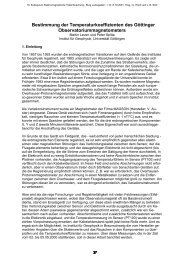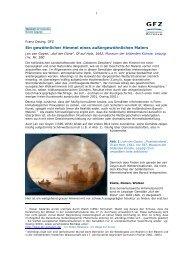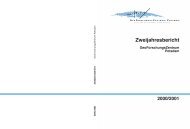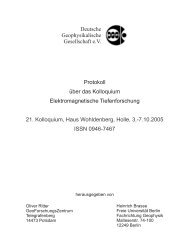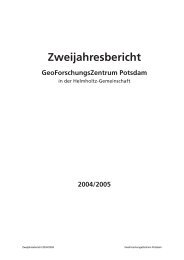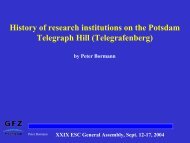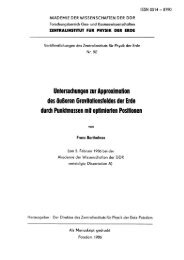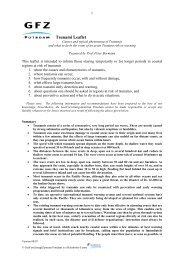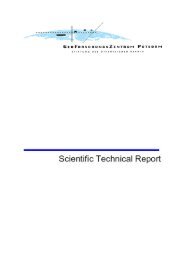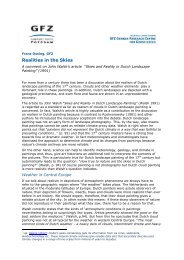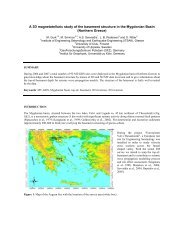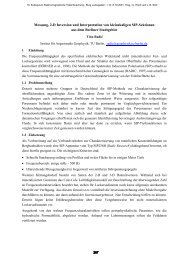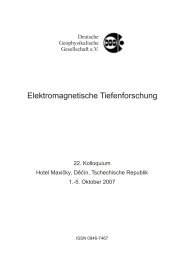Establishing Controlled Source MT at GFZ
Establishing Controlled Source MT at GFZ
Establishing Controlled Source MT at GFZ
You also want an ePaper? Increase the reach of your titles
YUMPU automatically turns print PDFs into web optimized ePapers that Google loves.
Figure 2: 1D Occam inversion of synthetic CS<strong>MT</strong> d<strong>at</strong>a. The d<strong>at</strong>a are the real and imaginary parts of the inline<br />
electric field, contamin<strong>at</strong>ed with white noise with 1% of the signal amplitude. In addition, white noise with a<br />
standard devi<strong>at</strong>ion of 10 -9 V/m was added. a) Inversion of the sp<strong>at</strong>ial decay of the field for a single frequency (1<br />
Hz), using an unconstrained Occam inversion and using an Occam variant where the devi<strong>at</strong>ion from an a priori<br />
model is penalized outside of the depth of interest. b) Inversion of the frequency spectrum recorded <strong>at</strong> 5 km<br />
distance from the transmitter.<br />
Figure 3: Comparison of single and joint 1D inversion models for passive <strong>MT</strong> and CS<strong>MT</strong> d<strong>at</strong>a. In (a), the left panel<br />
shows passive <strong>MT</strong> d<strong>at</strong>a (apparent resistivity and phase) for the true model and <strong>MT</strong> inversion result displayed in the<br />
right panel. In (b), CS<strong>MT</strong> d<strong>at</strong>a (real and imaginary part of the inline electric field) are displayed for the true<br />
resistivity model and CS<strong>MT</strong> inversion result. (c) shows the resistivity model resulting from joint <strong>MT</strong> and CS<strong>MT</strong><br />
inversion. In this example, the <strong>MT</strong> d<strong>at</strong>a add inform<strong>at</strong>ion only <strong>at</strong> gre<strong>at</strong>er depths, where the sensitivity of CS<strong>MT</strong><br />
sounding is low. In practice, we anticip<strong>at</strong>e th<strong>at</strong> <strong>MT</strong> d<strong>at</strong>a will help construct a (2D/3D) regional background model,<br />
and CS<strong>MT</strong> d<strong>at</strong>a will help refine the model <strong>at</strong> reservoir scale (1D/3D).<br />
dependency of the fields, whereas marine applic<strong>at</strong>ions will primarily exploit sp<strong>at</strong>ial vari<strong>at</strong>ions of the<br />
fields.<br />
We have implemented a 1D CS<strong>MT</strong> inversion based on Weidelt’s formul<strong>at</strong>ion of the forward problem<br />
(Weidelt, 2007), and analytically derived expressions for the Jacobian m<strong>at</strong>rix required in the inversion.<br />
Finite source dipoles (Streich and Becken, this issue) have been incorpor<strong>at</strong>ed into the inversion;<br />
however, in the present form of the inversion scheme, the source and receivers are placed <strong>at</strong> the<br />
surface. Here, we only consider horizontal electric point dipole sources. The inversion is similar to<br />
23. Schmucker-Weidelt-Kolloquium für Elektromagnetische Tiefenforschung,<br />
Heimvolkshochschule am Seddiner See, 28 September - 2 Oktober 2009<br />
74



